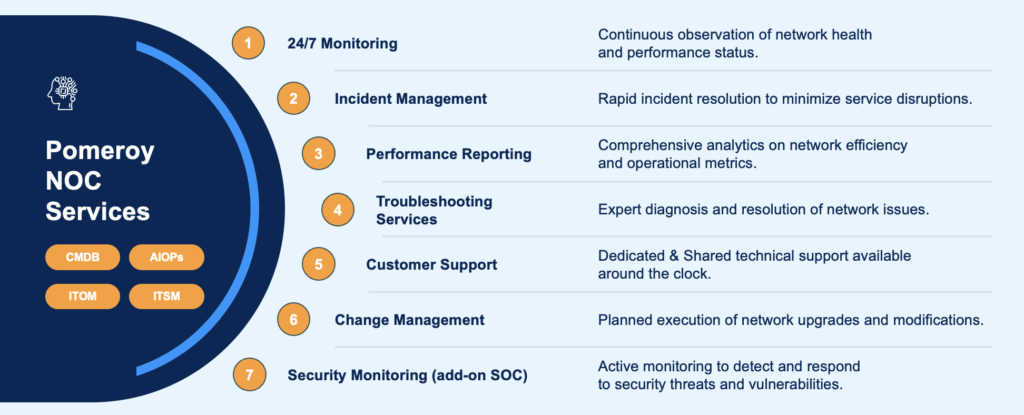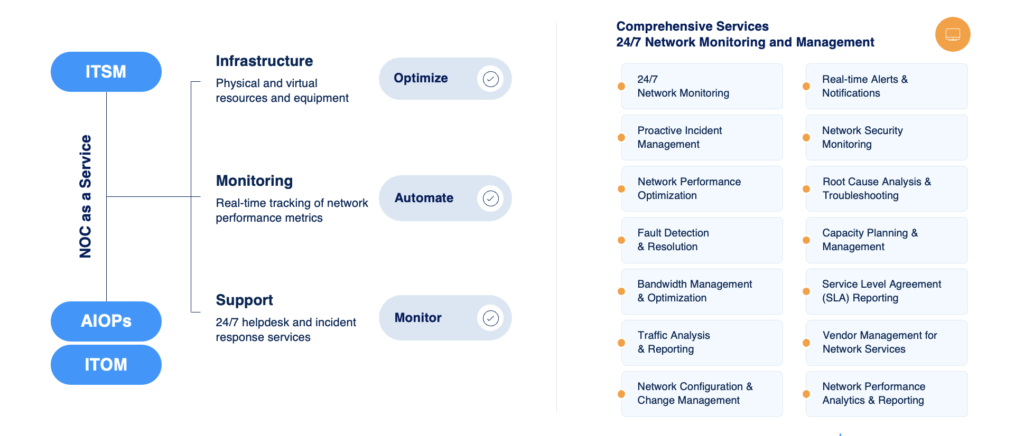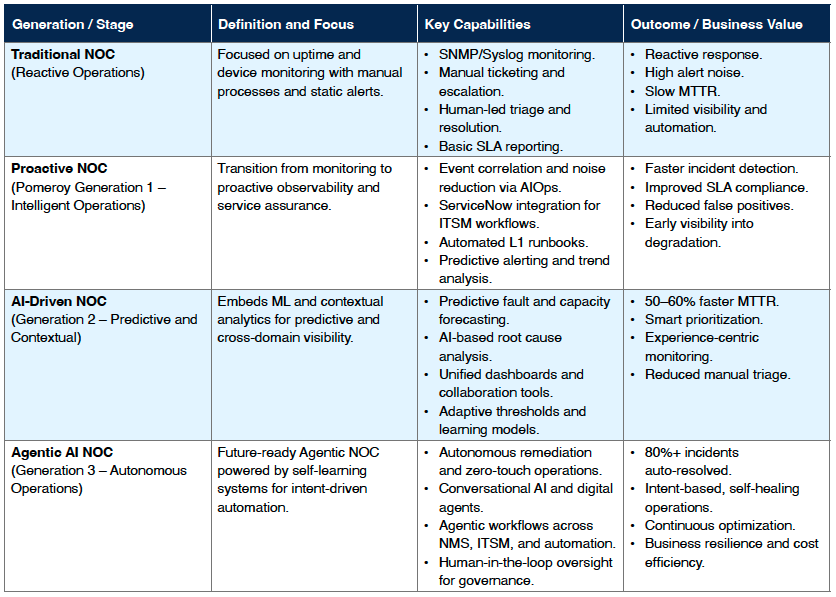The network is the backbone of business operations in today’s digital-first economy. From cloud-based applications to remote collaboration, organizations depend on highly available, secure, and optimized networks. Yet, managing a modern network environment is no small task. The complexity of hybrid infrastructures, the demand for 24/7 uptime, and the growing volume of alerts put tremendous pressure on IT teams.
What is NOC as a Service?
Rather than investing in building and staffing an in-house Network Operations Center, organizations can subscribe to NOC as a Service, a scalable, outcome-driven solution. This approach leverages the provider’s advanced tools, skilled engineers, and automation frameworks, allowing businesses to efficiently manage their networks while focusing internal resources on strategic initiatives. NOCaaS includes:
- 24/7 monitoring and alerting – Continuous oversight of routers, switches, firewalls, WAN links, cloud networks, and datacenter environments.
- Incident detection and resolution – Proactively identifying and resolving outages, degradations, and configuration issues.
- Performance optimization – Ensuring network speed, stability, and Quality of Service (QoS) for mission-critical applications.
- Reporting and analytics – Transparent dashboards and SLA-driven reports for visibility and compliance.
- Automation and AIOps – AI-driven correlation, noise reduction, and automated remediation for faster mean time to resolution (MTTR).
Why enterprises need NOCaaS
- Cost efficiency: Building a traditional NOC requires significant investments in infrastructure, tools, and specialized talent. NOCaaS shifts this to an OPEX model, reducing upfront costs while providing predictable monthly expenses.
- Scalability and flexibility: As networks expand to support cloud, IoT, and edge computing, scaling operations internally becomes difficult. NOCaaS providers can dynamically scale monitoring, tools, and staffing to match business growth.
- Access to expertise: Network engineers with multi-domain expertise (routing, switching, SD-WAN, firewalls, cloud networking, etc.) are expensive and difficult to retain. NOCaaS ensures round-the-clock access to specialized skill sets.
- Improved uptime and reliability: Through proactive monitoring and rapid incident response, enterprises benefit from higher availability and reduced downtime, directly impacting productivity and customer experience.
- Focus on core business: Internal IT teams can focus on strategic initiatives like digital transformation, cloud adoption, and security enhancements by outsourcing repetitive monitoring and incident-handling tasks.
Key components of NOC as a Service

Market Trends
- By 2027, Gartner predicts that generative AI (GenAI) will account for 25%+ of initial network configuration, up from less than 3% in 2024. This shift underscores the growing reliance on AI to streamline network operations.
- Enterprises increasingly seek service providers that can offer innovative solutions and demonstrate clear value propositions. There is a growing emphasis on proactive monitoring, automation, and the integration of AI to enhance service delivery and operational efficiency.
- Organizations are moving towards outsourced NOC/managed network models to leverage specialized expertise and reduce operational costs.
- Modern Networking is adaptive, secure, and cloud-ready, enabling seamless connectivity, real-time visibility, and intelligent control across dynamic IT environments.
Key trends driving NOCaaS adoption
Several core technology developments are fueling enterprise interest in NOCaaS:
- AI and AIOps automation: Predictive analytics and automation enable quick issue resolution, enhancing operational efficiency and driving NOCaaS adoption.
- Cloud-first observability: Unified visibility across diverse environments allows faster troubleshooting and encourages the use of NOCaaS for comprehensive management.
- Zero-touch operations: Self-healing automation minimizes manual tasks, making NOCaaS more appealing for streamlined network operations.
- Integrated ITSM and SOC workflows: Seamless incident response integration improves resolution times, prompting organizations to embrace NOCaaS solutions.
- Outcome-based SLAs: Focusing on user experience and business outcomes enhances the relevance of NOCaaS, aligning it with organizational goals.
- Full-Stack observability: Correlating metrics, logs, and traces provides deeper insights, driving interest in NOCaaS for proactive network management.
- Edge and IoT visibility: Extending network oversight to edge environments ensures comprehensive control, increasing the necessity for NOCaaS.
- Agentic and conversational AI (emerging): Human-AI collaboration enhances efficiency and responsiveness, motivating the adoption of NOCaaS for advanced operations.
Also read: Key Security Trends in Networking Technology in 2025
Operational architecture

Benefits:
- Better uptime, faster incident response, and efficient resource utilization
- Faster incident detection and resolution
- Lower support and maintenance overhead
- Enhanced SLA adherence
- Reduced operational risk and downtime,
- Supports infrastructure uptime for public services
- Faster incident detection and resolution
- Lower support and maintenance overhead.
- Up to 40% reduction in outages and support escalations.
- All services are monitored, managed, and optimized from a centralized single window NOC for consistent performance, security, and availability.
The risks of not adopting NOCaaS
Increased downtime costs due to outages can reach thousands of dollars per minute. Internal teams often struggle with skill gaps, lacking the 24/7 expertise required for complex environments. Without automation and AIOps, slow incident resolution is common, leading to alert fatigue and delayed responses.
Additionally, legacy Network Operations Centers (NOCs) frequently face scalability issues, unable to meet the demands of hybrid and multi-cloud networking.
NOC as a Service Evolution
Traditional NOCs focus on uptime but are slow and noisy due to manual processes. Proactive NOCs (Gen 1) improve with intelligent monitoring and automation, enhancing incident detection and SLA compliance. AI-Driven NOCs (Gen 2) use machine learning for predictive analytics, improving MTTR and minimizing manual intervention. Agentic AI NOCs (Gen 3) feature self-learning and zero-touch operations, achieving over 80% automated incident resolution, boosting resilience and efficiency.
Agentic AI NOCaaS offers comprehensive network management and monitoring features, including 24/7 real-time monitoring and tiered support from Level 1 to Level 3. The service utilizes AI for incident detection, automated ticketing, and resolution workflows. Organizations benefit from SLA dashboards, reporting, and solutions for edge networks, multi-cloud, datacenter, LAN, WLAN, WAN, and SD-WAN.
Agentic AI NOCaaS also streamlines network management, reducing mean time to resolution (MTTR) and increasing availability and performance. It provides centralized visibility and control, integrates with AI-driven service management, and promotes faster incident responses. Businesses can expect reduced outages and support escalations, with potential reductions of up to 40%.
The Evolution of Network Operations Centers (NOCs)

Looking ahead to the future state of networking
NOC as a Service is more than outsourced monitoring—it’s a strategic enabler for enterprises navigating the complexities of modern networking. Combining automation, analytics, and skilled expertise, NOCaaS delivers higher uptime, lower costs, and future-ready operations.
In a world where the network is business-critical, enterprises that adopt NOCaaS gain operational resilience and the agility to focus on innovation. This shift from reactive firefighting to proactive, intelligent network management is quickly becoming a competitive advantage for mid-to-large enterprises.
Also read: Building a Better Workplace: The Significance of Human-Centered AI
Questions? Get in touch.




